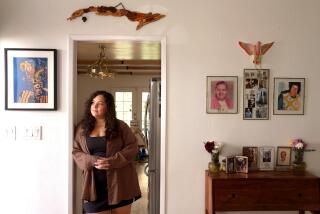SOUTHWEST AREA : Arts Programs Find a Home at CASA
- Share via
James Burks said he always thought the arts were a terrible thing to waste, particularly when it came to children already shortchanged by public schools that were eliminating arts programs to accommodate shrinking budgets.
“What I felt kids needed was an alternative to an academic environment they got six hours a day,” said Burks, director of the William Grant Still Art Center in Southwest Los Angeles. “I also felt that people have to stop throwing away art instructors who are right here in the community.”
To address what he saw as twofold neglect, Burks joined forces with Assemblywoman Gwen Moore (D-Los Angeles), who contacted him in April, 1992, about implementing a citywide arts program, something he had already begun outlining. The result was Creative After School Alternatives (CASA), a low-cost after-school program that turns eight Southwest-area art and cultural centers into creative playgrounds for fourth- through 11th-grade students five days a week.
Although the program has met Burks’ expectations, CASA is off to a sluggish start after opening last month. The 18 Los Angeles Unified School District campuses that have agreed to distribute registration forms have been slow in getting the word out, he said. Thus far, CASA has only about 30 students in a program that has a capacity for 300. Plans for free bus transportation from schools to CASA sites are under discussion, said Maisha Hazzard, CASA director.
But Hazzard, who works with Moore’s office, said it is only a matter of time before parents and students take advantage of CASA. “The bottom line is: We want to serve the kids,” Hazzard said. “We’re very serious about getting them into the arts. This program is one of the most positive ways we can foster better communication among kids while at the same time helping out the artists who need the work.”
CASA conducts programs at eight sites in an area bounded by Pico Boulevard to the north, Slauson Avenue to the south, Denker Avenue to the east and Fairfax Avenue to the west:
* Blackstreet USA Puppet Theater,
* Communication Bridge Institute,
* Dance Collective,
* Ebony Showcase Theater,
* Fire Station No. 18,
* Los Angeles Contemporary Dance Theatre,
* St. Elmo Village,
* William Grant Still Art Center.
A registration fee of $25 covers classes five days a week, 3 to 6:30 p.m., for 10 weeks. Besides instruction in such disciplines as dance, acting and creative writing, the program offers training in the business and technical aspects of the arts, including stagecraft, museum curating and play production.
“We want to teach kids about art-related careers, not just art,” said Hazzard. “Art is also a business. We want to emphasize to kids that they can make money in many different ways, while helping their community at the same time. We want to show them how far they can really go.”
Funded by about $200,000 in start-up money from the California Arts Council, the National Endowment for the Arts and the Arco Foundation, the program is in search of additional operating funds, said Hazzard.
Gary Jones, puppeteer and proprietor of Blackstreet USA Puppet Theater, said the greatest hurdle is getting students in the door. Once that happens, he said, “the magic of the arts take over.”
But Jones said he will teach students that his stage show is simply the visible surface of an in-depth process. “I not only make the puppets, but I operate them, book shows and tours,” he said. “In the arts, you frequently have to be an expert in many different areas. And it all takes constant practice.”
Johnny Johnson, 11, carefully working the eyes and mouth of a puppet under Jones’ tutelage, seemed more than willing to do just that. “I think I could do this,” he said, grinning. “I’ve never done puppets before. . . . I only draw pictures. But I could learn.”
More to Read
Sign up for Essential California
The most important California stories and recommendations in your inbox every morning.
You may occasionally receive promotional content from the Los Angeles Times.










